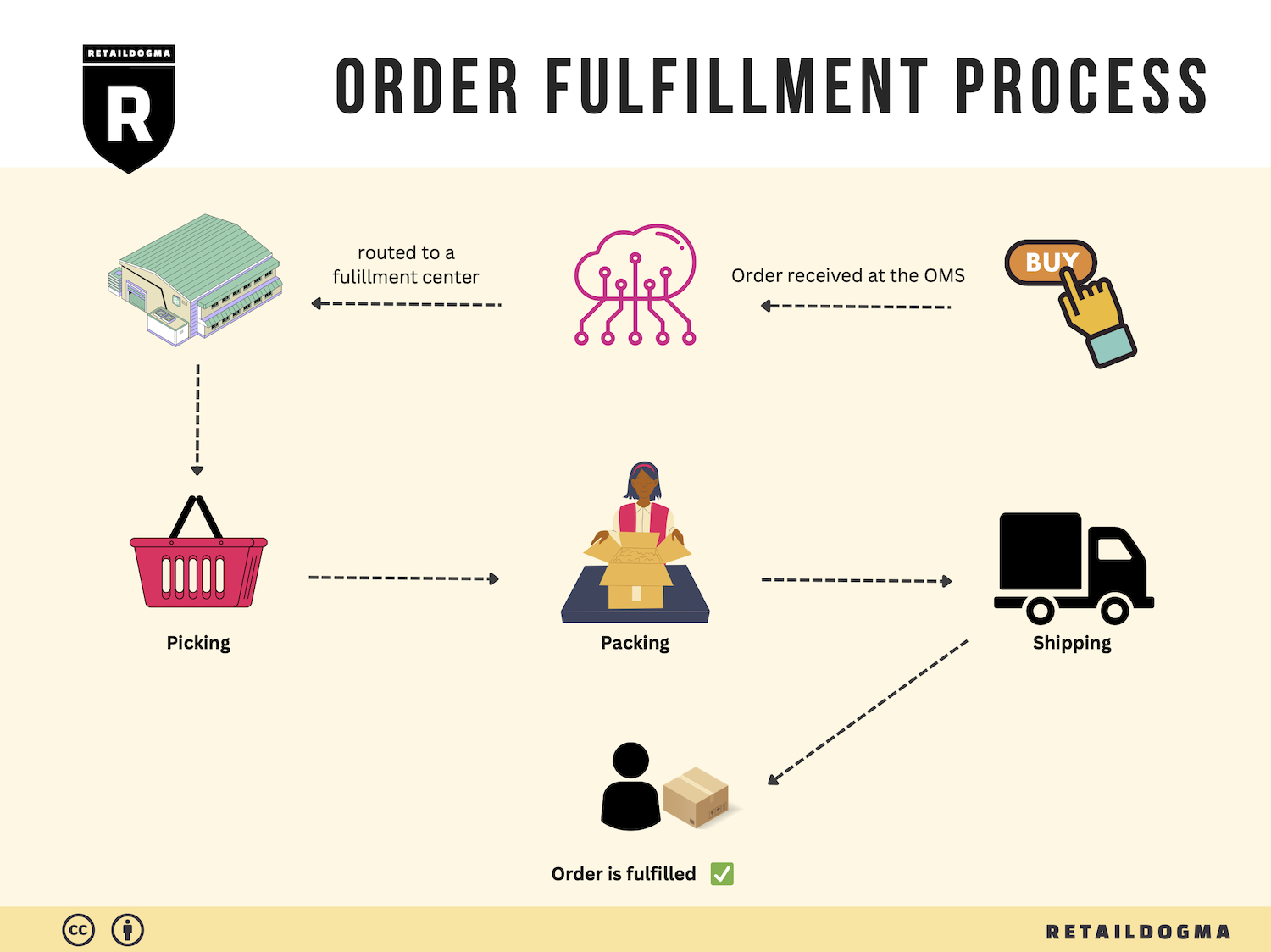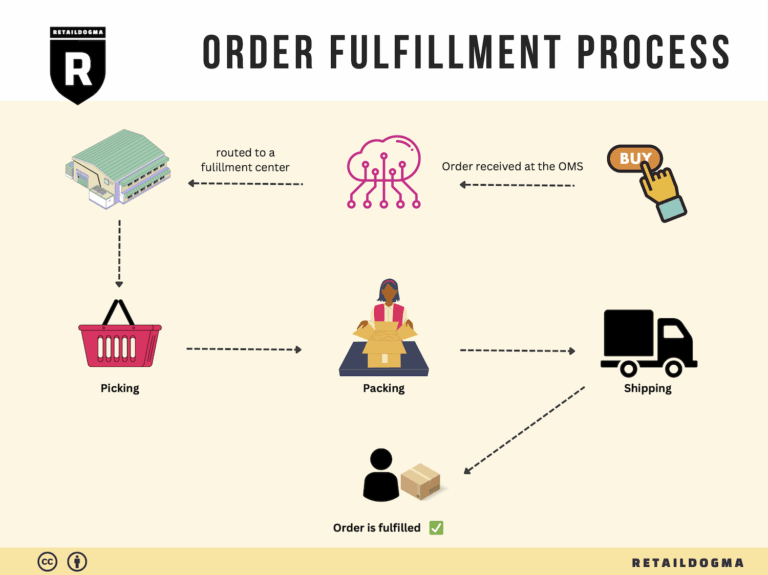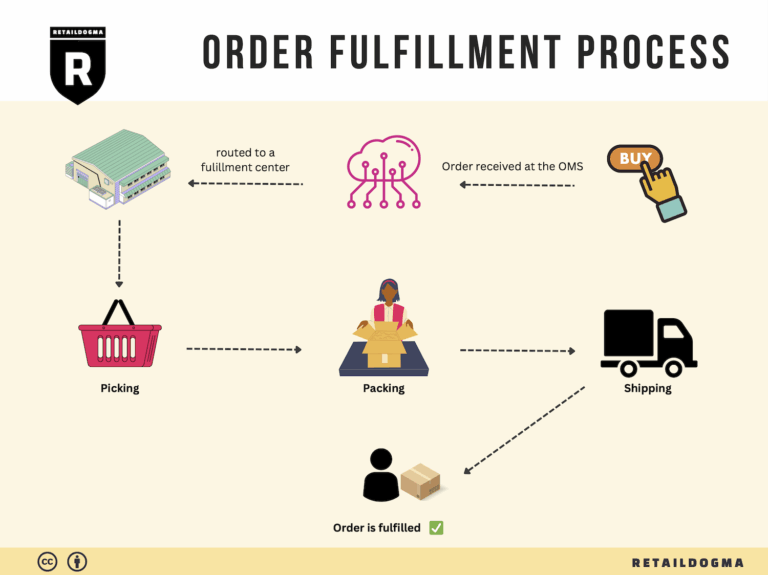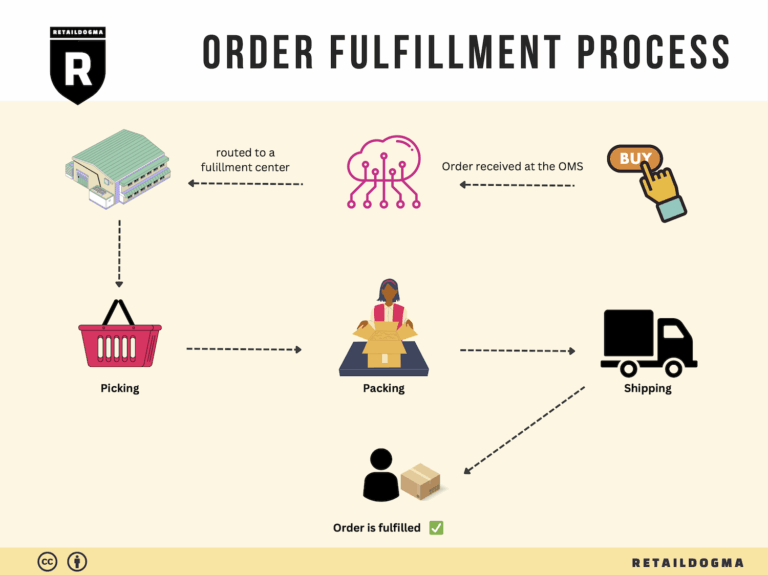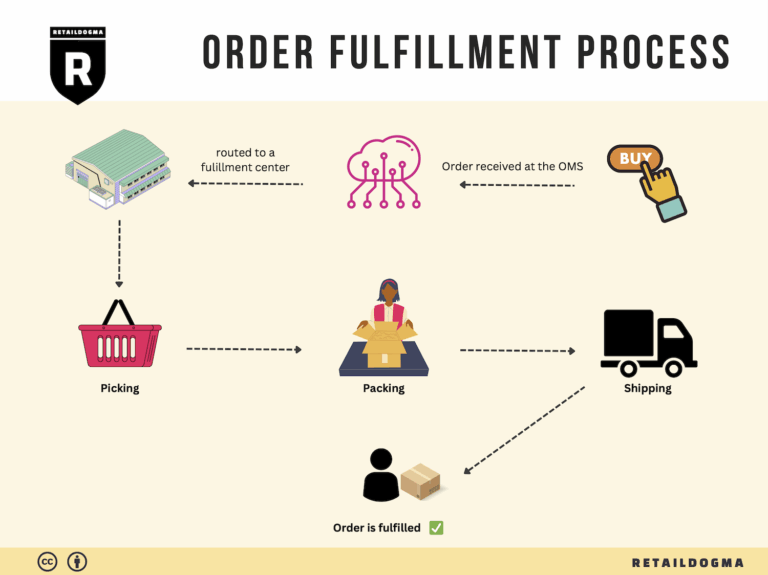Ecommerce Fulfillment Services: The Ultimate Guide (2025)
What is E-commerce Fulfillment? An Introduction for Growing Businesses
Understanding E-commerce Fulfillment: A Key to Scaling Your Business
As a growing e-commerce business owner, you might find yourself overwhelmed with the intricacies of packing and shipping orders. Managing inventory, ensuring timely deliveries, and maintaining customer satisfaction can feel like a daunting task, especially as your sales begin to scale. This is where effective e-commerce fulfillment comes into play. In simple terms, fulfillment is the process of getting a product from your inventory to your customer’s doorstep, and it encompasses everything from storage and packing to shipping and tracking.
This guide aims to demystify e-commerce fulfillment for you, providing a comprehensive understanding of the different models available, such as Third-Party Logistics (3PL) and Fulfillment by Amazon (FBA). Each model has its advantages and is tailored to different business needs, whether you are just starting out or already experiencing significant growth. We will break down the core services that fulfillment partners typically offer, including inventory management, order processing, and returns handling, so you can identify which services align best with your operational requirements.
Selecting the right fulfillment partner is crucial for your business’s success. We will discuss the key factors to consider when choosing a partner, such as location, scalability, technology integration, and customer service. Understanding these elements will empower you to make informed decisions that can enhance your operational efficiency and customer experience.
Pricing is another critical aspect of e-commerce fulfillment that can significantly impact your bottom line. We will explore the various pricing structures you may encounter, including per-order fees, storage costs, and additional service charges, helping you to budget effectively and avoid unexpected expenses.
Ultimately, this guide’s goal is to empower you with the knowledge and insights needed to make smart decisions about your logistics strategy. By understanding the nuances of e-commerce fulfillment, you can streamline your operations, reduce overhead costs, and focus on what truly matters: growing your business and delighting your customers. Let’s dive into the world of e-commerce fulfillment and unlock the potential for your business’s success.
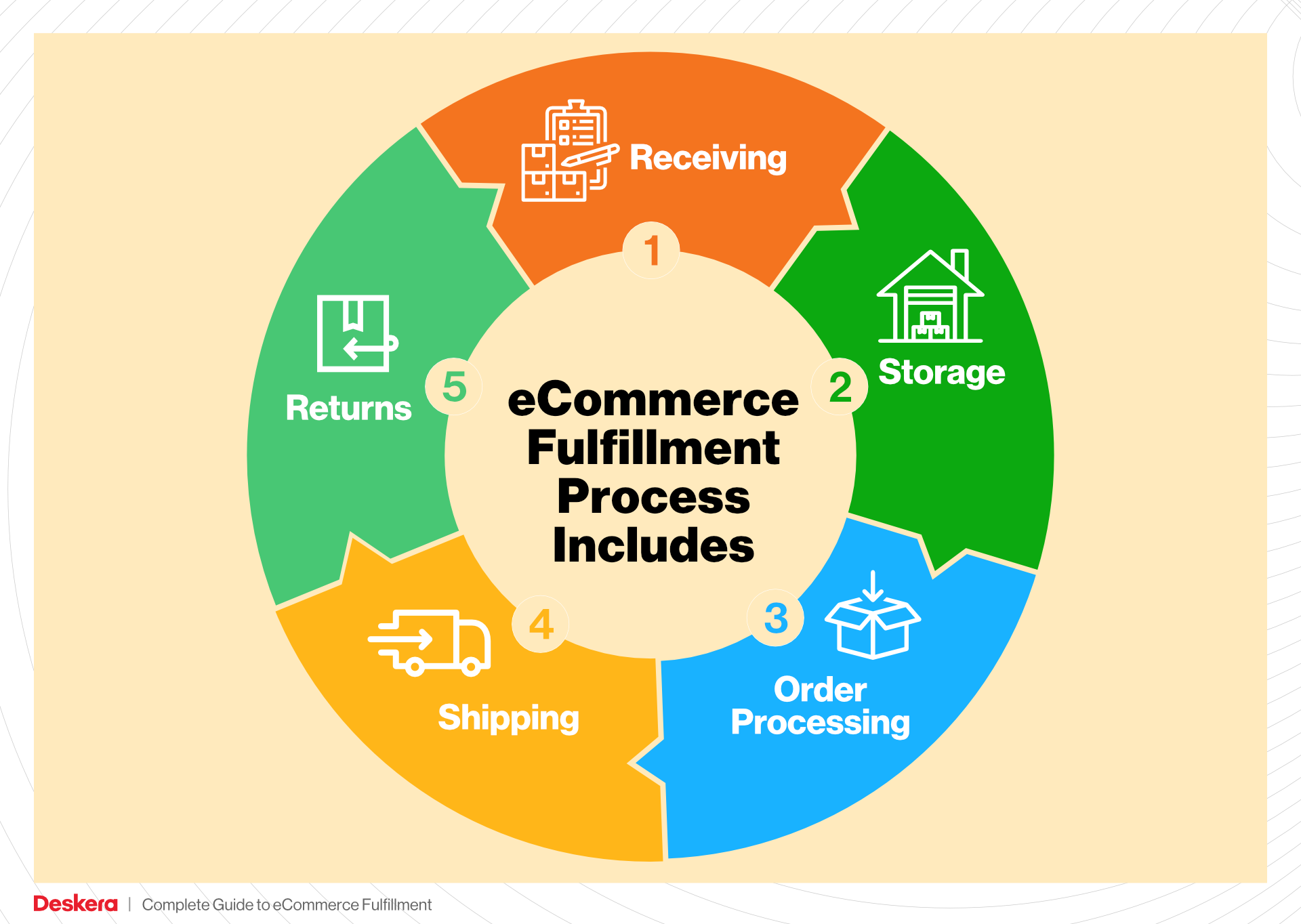
What You’ll Learn In This Guide
- What is E-commerce Fulfillment? An Introduction for Growing Businesses
- The Order Fulfillment Process: From ‘Buy’ Button to Customer’s Door
- Comparing Fulfillment Models: In-House vs. 3PL vs. Dropshipping
- A Deep Dive into Amazon FBA: Pros, Cons, and Who It’s For
- Core Services Offered by Fulfillment Centers
- How to Choose a Fulfillment Partner: A 6-Point Checklist
- Understanding Fulfillment Pricing: A Breakdown of Common Fees
- Frequently Asked Questions (FAQs) about Fulfillment
- Conclusion: Is Outsourcing Fulfillment the Right Move for Your Business?
- Important Disclaimer
The Order Fulfillment Process: From ‘Buy’ Button to Customer’s Door
1. Receiving Inventory
The order fulfillment process begins with receiving inventory, a critical step that sets the stage for efficient operations. When products arrive at the fulfillment center, they are checked for quality and quantity against purchase orders. This process typically involves the use of Stock Keeping Units (SKUs), unique identifiers that help in tracking products throughout the supply chain.
Proper inventory receiving ensures that any discrepancies or damages are addressed immediately, preventing future issues that could disrupt order fulfillment. It is essential for maintaining accurate stock levels, which in turn impacts inventory management and order accuracy. This step is crucial as it lays the groundwork for the entire fulfillment process, ensuring that the warehouse has the correct items available for customer orders.
2. Warehouse Storage
Once the inventory is received and verified, it is moved to storage areas within the fulfillment center. Efficient warehouse storage is vital for optimizing space and facilitating quick access to products. This process often employs systematic storage solutions such as pallet racking, shelving, or automated storage systems, depending on the size and nature of the inventory.
Effective storage methods not only enhance accessibility but also minimize the time needed to retrieve items when orders are placed. The organization of the warehouse can significantly affect the speed and efficiency of order fulfillment. A well-structured storage system allows for better inventory management, helping to prevent stockouts or overstock situations that can lead to increased costs and lost sales opportunities.
3. Order Picking
The next step in the fulfillment process is order picking, where items are selected from the warehouse to fulfill customer orders. This step is crucial because it directly impacts order accuracy and customer satisfaction. Order pickers typically use tools such as pick lists or mobile devices to identify and locate products quickly.
There are various picking methods, including single order picking, batch picking, and zone picking, each suited to different warehouse layouts and order volumes. The choice of method can influence the efficiency of the picking process. Efficient order picking minimizes the time spent locating and retrieving items, thereby reducing the overall lead time for delivering orders to customers.
4. Order Packing
Once the items are picked, they are moved to the packing station, where they are prepared for shipment. Order packing is an essential step that involves securely packaging items to prevent damage during transit. This process may include the use of packing slips, cushioning materials, and appropriate shipping boxes tailored to the size and nature of the products.
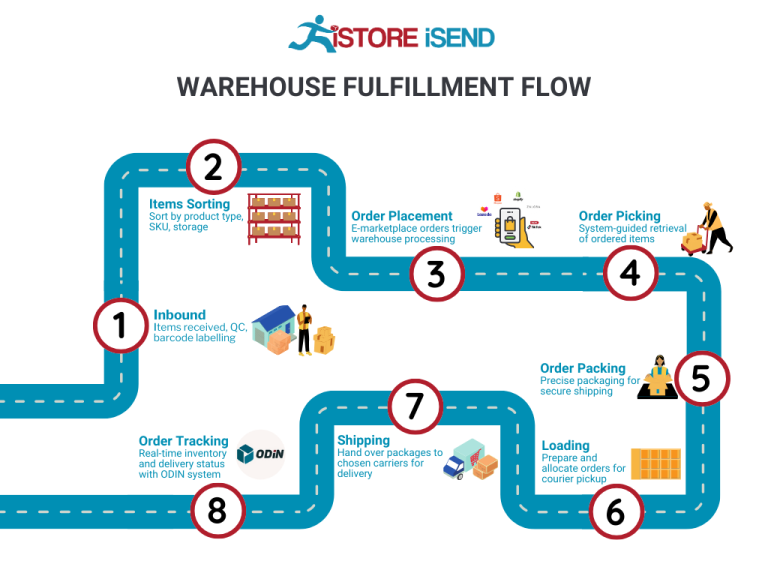
Effective packing not only protects items but also enhances the unboxing experience for customers, which can significantly influence repeat business and brand loyalty. Additionally, well-packed shipments can help optimize shipping costs by minimizing dimensional weight charges. This step is critical in ensuring that products reach customers in perfect condition, thereby maintaining the integrity of the brand and customer satisfaction.
5. Shipping & Delivery
The final step in the order fulfillment process is shipping and delivery, where packaged orders are dispatched to customers. This stage involves selecting the appropriate shipping method and carrier based on factors such as delivery speed, cost, and destination. Companies often utilize logistics software to streamline this process, enabling real-time tracking and management of shipments.
Efficient shipping and delivery are paramount for meeting customer expectations in today’s fast-paced e-commerce environment. This step not only impacts the customer experience but also plays a crucial role in managing operational costs. Timely delivery can enhance customer satisfaction and loyalty, while delays can lead to dissatisfaction and potential loss of business. Therefore, optimizing shipping routes and partnering with reliable carriers are essential for success in the e-commerce landscape.
By understanding and implementing these five steps—receiving inventory, warehouse storage, order picking, order packing, and shipping & delivery—e-commerce businesses can enhance their order fulfillment processes, ultimately leading to improved customer satisfaction and increased sales.
Comparing Fulfillment Models: In-House vs. 3PL vs. Dropshipping
Fulfillment Model Comparison
| Model | Who Handles Inventory | Best For (Business Stage) | Key Advantage | Key Disadvantage |
|---|---|---|---|---|
| In-House Fulfillment | The business itself | Established businesses | Full control over inventory and operations | High overhead costs and labor intensity |
| Third-Party Logistics (3PL) | External logistics provider | Growing businesses | Scalability and flexibility | Less control over the fulfillment process |
| Dropshipping | Supplier | Startups and small businesses | Low overhead costs | Lower profit margins and reliance on suppliers |
In-House Fulfillment
In-house fulfillment refers to the practice where a business manages its entire logistics process, including inventory storage, order processing, and shipping, within its own facilities. This model is ideal for established businesses that have the resources and infrastructure to handle the complexities of logistics. The primary advantage of in-house fulfillment is the level of control it offers. Businesses can directly manage their inventory, customize packaging, and ensure quality control at every step of the process. This can lead to better customer satisfaction and brand loyalty, as companies can tailor their logistics to align with their brand image.
However, in-house fulfillment comes with significant drawbacks. The overhead costs can be substantial, as businesses must invest in warehouse space, technology, and labor. Additionally, maintaining an in-house operation can be labor-intensive, requiring dedicated staff and continuous management. For businesses looking to scale, the rigid structure of in-house fulfillment can become a bottleneck, particularly during peak seasons when demand fluctuates.
Third-Party Logistics (3PL)
Third-party logistics (3PL) involves outsourcing logistics functions to an external service provider. This model is increasingly popular among growing businesses that require a more flexible and scalable solution. 3PL providers handle inventory management, warehousing, shipping, and even returns processing, allowing businesses to focus on their core competencies like product development and marketing.
The key advantage of using a 3PL provider is scalability. As your business grows, a 3PL can adjust its services to meet your changing needs, whether that involves increasing warehouse space or optimizing shipping routes. This flexibility is crucial in today’s fast-paced e-commerce environment, where consumer demands can shift rapidly. However, the trade-off is a loss of control over the fulfillment process. Businesses may find it challenging to maintain consistent service quality or to respond quickly to issues that arise within the logistics chain. Additionally, the costs can vary significantly based on the services required, which may complicate budgeting.
Dropshipping
Dropshipping is a fulfillment model where the retailer does not hold inventory but instead transfers customer orders directly to a supplier, who then ships the products to the customer. This model is particularly appealing for startups and small businesses with limited capital, as it requires minimal upfront investment in inventory and infrastructure.
The primary advantage of dropshipping is the low overhead costs associated with not having to maintain a warehouse or handle inventory. This allows new entrepreneurs to test various products and markets without significant financial risk. Furthermore, dropshipping enables businesses to offer a wide range of products, as they are not restricted by the limitations of their own inventory.
However, dropshipping also has notable disadvantages. Profit margins can be lower compared to other fulfillment models, as retailers typically pay a higher price per unit to suppliers. Additionally, reliance on suppliers for inventory and shipping means that businesses have less control over product quality and delivery times, which can lead to customer dissatisfaction. In an increasingly competitive market, ensuring a seamless customer experience becomes critical, and any hiccups in the dropshipping process can damage a brand’s reputation.
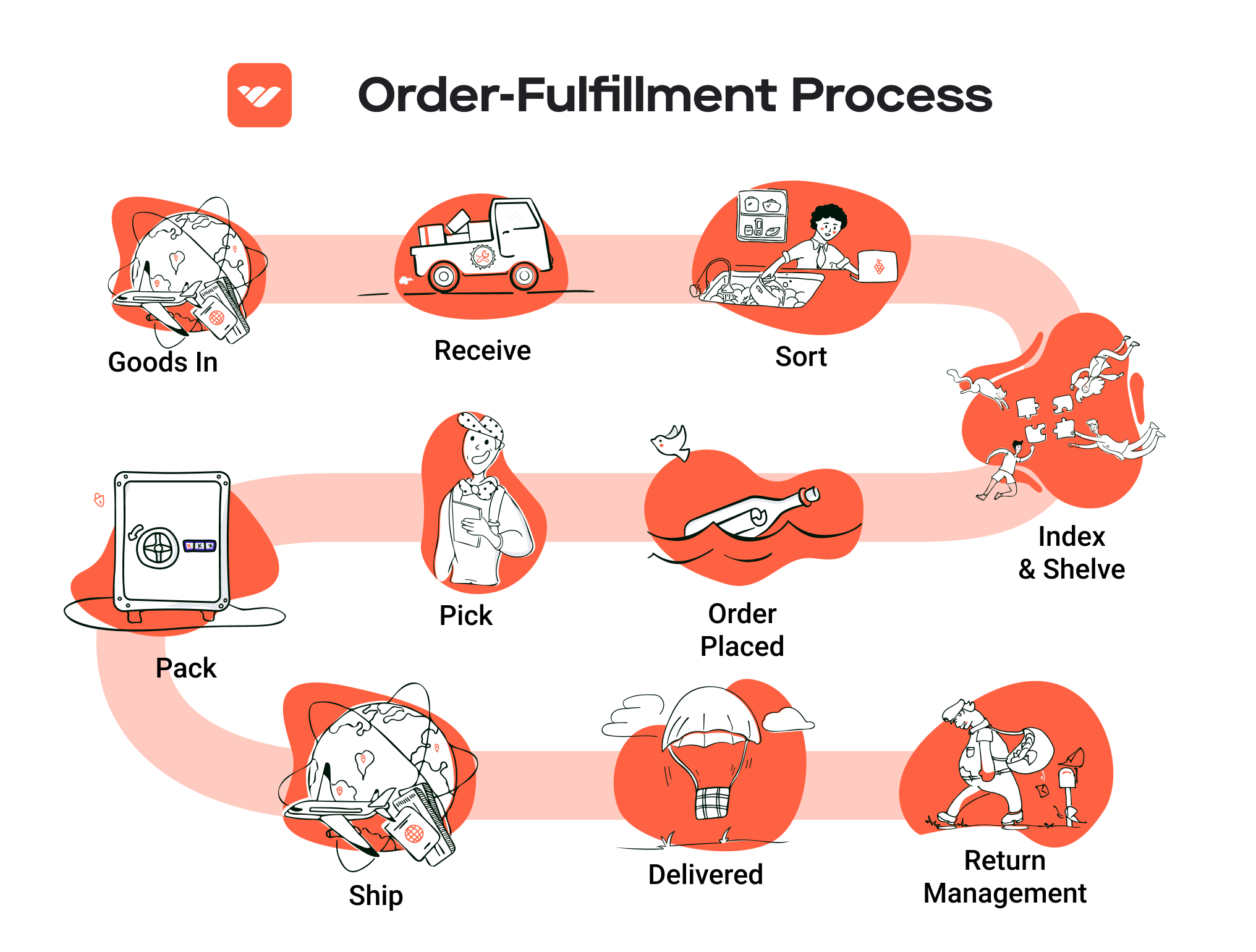
Conclusion
Choosing the right fulfillment model is essential for e-commerce businesses looking to scale efficiently. Each model offers unique advantages and disadvantages, and the best choice depends on various factors, including the business’s stage, resources, and growth objectives. Established businesses may benefit from the control of in-house fulfillment, while growing companies might find 3PLs provide the scalability they need. Startups and small businesses can leverage dropshipping to minimize risk and test market waters, albeit with the understanding of its inherent limitations. By carefully evaluating these models, e-commerce entrepreneurs can align their logistics strategies with their overall business goals, ensuring a path toward sustainable growth.
A Deep Dive into Amazon FBA: Pros, Cons, and Who It’s For
Understanding Fulfillment by Amazon (FBA)
Fulfillment by Amazon (FBA) is a service that allows sellers to store their products in Amazon’s fulfillment centers. Amazon takes care of storage, packaging, and shipping of products directly to customers. This service is designed to simplify the logistics of e-commerce for sellers, enabling them to focus on other aspects of their business, such as product sourcing and marketing.
When a customer places an order for a product fulfilled by Amazon, the company handles the entire process—from picking the product from the shelf to packaging and shipping it. Additionally, Amazon provides customer service and handles returns for these orders. This end-to-end solution makes FBA a popular choice for e-commerce entrepreneurs looking to scale their operations.
How FBA Works
-
Setup: Sellers need to create an Amazon seller account and enroll in the FBA program. Once enrolled, they can list their products as FBA items.
-
Inventory Shipment: Sellers then prepare their products according to Amazon’s guidelines and ship them to Amazon’s fulfillment centers. It’s crucial to follow Amazon’s packaging and labeling requirements to avoid delays.
-
Storage and Management: Once the products arrive at the fulfillment center, they are stored until an order is placed. Sellers can monitor their inventory levels via the Amazon Seller Central dashboard.
-
Order Fulfillment: When a customer orders an FBA product, Amazon picks, packs, and ships the item directly to the customer. The seller is notified of the sale, and the product is removed from their inventory.
-
Customer Service: Amazon handles all customer inquiries and returns related to FBA products, providing a seamless experience for the customer.
Pros of Using FBA
-
Prime Eligibility: One of the most significant advantages of FBA is that products are eligible for Amazon Prime. This can significantly increase sales as Prime members are often more likely to purchase items that come with fast, free shipping.
-
Customer Trust: Utilizing FBA can enhance a seller’s credibility. Customers are more likely to purchase from sellers that use Amazon’s services, as they trust Amazon’s brand for reliable shipping and customer service.
-
Multi-Channel Fulfillment: FBA isn’t limited to Amazon sales alone. Sellers can use Amazon’s fulfillment services to ship products sold on other platforms (like their own websites or eBay), streamlining logistics across multiple sales channels.
-
Time Efficiency: FBA automates much of the logistics process, freeing up sellers to focus on other critical aspects of their business, such as product development and marketing.
-
Scalability: FBA allows sellers to scale their operations quickly without needing to invest in warehousing or additional logistics infrastructure.
Cons of Using FBA
-
High Fees: While FBA simplifies many aspects of e-commerce, the fees can be substantial. Sellers must pay storage fees for their inventory and fulfillment fees per item sold, which can significantly cut into profit margins.
-
Strict Inventory Rules: Amazon has stringent inventory management rules, including limits on the number of units a seller can store. Sellers must carefully manage their inventory to avoid long-term storage fees and ensure they have enough stock to meet demand.
-
Commingling Risks: FBA often involves commingling inventory with that of other sellers. This means that sellers could potentially receive returns or orders for products that are not theirs, leading to confusion and potential brand reputation issues.
-
Loss of Control: When using FBA, sellers give up some control over the fulfillment process. This can be concerning if a seller has specific packaging or shipping requirements that differ from Amazon’s standard practices.
-
Complex Returns: Handling returns through Amazon can sometimes be complicated, especially if a seller has unique return policies that differ from Amazon’s.
Who is FBA Best For?
Fulfillment by Amazon is particularly beneficial for:
-
Small to Medium-Sized Businesses: Entrepreneurs with limited resources can leverage Amazon’s extensive logistics network without the need for their own warehouse.
-
Brands Looking for Growth: Sellers aiming to scale their operations quickly and reach a broader audience can greatly benefit from the Prime eligibility and customer trust that comes with FBA.
-
E-commerce Entrepreneurs: Individuals who want to focus on sales and marketing rather than logistics will find FBA’s automated processes advantageous.
-
Multi-Channel Sellers: Businesses that sell across various platforms will appreciate the convenience of using FBA to manage their inventory and fulfill orders from different channels.
In conclusion, while Fulfillment by Amazon offers significant advantages in terms of efficiency, customer trust, and scalability, it also comes with notable drawbacks, such as high fees and strict inventory rules. Sellers must carefully consider their business model and operational capabilities to determine if FBA aligns with their growth strategy.
Core Services Offered by Fulfillment Centers
Inventory Management & Warehousing
Inventory management and warehousing are foundational services offered by fulfillment centers that directly impact an e-commerce business’s efficiency and profitability. This service involves the systematic handling and storage of products in a dedicated facility, ensuring that stock levels are monitored, organized, and optimized for quick retrieval.
The primary benefit of effective inventory management is the reduction of holding costs and the minimization of stockouts or overstock situations. Fulfillment centers utilize advanced inventory management systems that provide real-time data on stock levels, allowing businesses to make informed decisions about reordering and product turnover. This is particularly crucial in a competitive e-commerce landscape where customer expectations for rapid delivery are high.
Moreover, fulfillment centers often implement best practices for warehouse organization, such as the use of FIFO (First In, First Out) systems, which ensure that older stock is sold first, reducing the risk of obsolescence. By outsourcing these functions to a fulfillment center, e-commerce businesses can focus on growth strategies rather than getting bogged down in the complexities of inventory control.
Pick and Pack Services
Pick and pack services are integral to the fulfillment process, where products are selected from inventory (picked) and then packaged for shipment (packed). This service is essential for e-commerce businesses that require efficient processing of orders to meet customer demand.
The key advantage of pick and pack services is the speed and accuracy with which orders are fulfilled. Fulfillment centers are equipped with trained staff and optimized workflows designed to ensure that the right products are picked and packed efficiently. Many centers employ advanced technology, such as barcode scanning and automated systems, to enhance accuracy and reduce human error, thereby increasing customer satisfaction.
Additionally, fulfillment centers can offer customized packing solutions, including branded packaging or specialized materials for fragile items. This not only protects products during transit but also enhances the unboxing experience for customers, which can lead to repeat business and positive reviews.
Kitting and Assembly
Kitting and assembly services involve the grouping of individual products into ready-to-ship sets or the assembly of products that require multiple components to function. This service is particularly valuable for e-commerce businesses that sell products requiring assembly or those that want to offer bundled deals.
The benefit of kitting and assembly is that it streamlines the fulfillment process for complex orders. Instead of managing multiple SKUs (Stock Keeping Units) for individual components, businesses can offer a single SKU for a kit, simplifying inventory management and order processing. This can lead to improved sales through upselling opportunities, as customers are often more inclined to purchase a bundled product at a perceived discount.
Furthermore, fulfillment centers have the expertise and equipment to handle assembly tasks efficiently, reducing the burden on in-house staff. This allows businesses to scale operations without needing to invest in additional labor or resources, making it an attractive option for growing e-commerce companies.
Returns Management (Reverse Logistics)
Returns management, or reverse logistics, is a critical service provided by fulfillment centers that addresses the handling of returned goods. This process includes receiving returned items, inspecting their condition, restocking or disposing of them, and processing refunds or exchanges.
The benefit of an efficient returns management system cannot be overstated, particularly in the e-commerce sector where return rates can be significantly higher than in traditional retail. A well-structured returns process enhances customer satisfaction by making it easy for customers to return unwanted or defective products. This can lead to increased trust and loyalty, encouraging customers to make future purchases despite their initial return experience.
Moreover, fulfillment centers can analyze return data to identify trends, such as frequently returned items or issues with product quality. This information can provide valuable insights for e-commerce businesses, enabling them to make informed decisions regarding product offerings, quality control, and customer service improvements.
In summary, the core services offered by fulfillment centers—inventory management and warehousing, pick and pack services, kitting and assembly, and returns management—are essential components for e-commerce businesses looking to scale efficiently. By leveraging these services, businesses can enhance operational efficiency, improve customer satisfaction, and ultimately drive sales growth in a competitive market.
How to Choose a Fulfillment Partner: A 6-Point Checklist
Location & Warehouse Network
Importance:
The geographic location of your fulfillment partner’s warehouses plays a crucial role in your shipping costs and delivery times. A partner with strategically located warehouses can ensure faster delivery to your customers, which is vital for maintaining customer satisfaction and loyalty.
Questions to Ask:
– Where are your warehouses located, and how do those locations align with my customer base?
– What is your average shipping time to major markets?
– Do you have plans for expanding your warehouse network in the near future?
Technology & Integrations
Importance:
In today’s digital landscape, having a technology-driven fulfillment process is essential. Your fulfillment partner should utilize advanced software for inventory management, order processing, and shipping. Seamless integrations with your e-commerce platform (like Amazon or Shopify) can enhance operational efficiency.
Questions to Ask:
– What technology do you use to manage inventory and orders?
– Can your system integrate with my e-commerce platform, and what is the process for setting this up?
– How do you ensure data accuracy and real-time inventory visibility?
Specializations (e.g., cold storage, oversized items)
Importance:
Depending on your product types, you may need a partner who specializes in certain areas, such as cold storage for perishables or the handling of oversized items. This specialization can make a significant difference in how well your products are stored and delivered.
Questions to Ask:
– Do you have experience handling products similar to mine? If so, can you provide case studies or references?
– What specific facilities and equipment do you have to handle specialized items?
– How do you manage compliance with industry standards for specialized storage needs?
Scalability & Capacity
Importance:
As your business grows, your fulfillment needs will change. A good partner should be able to scale with you, whether you experience seasonal spikes in demand or sustained growth. Understanding their capacity can help you avoid potential disruptions.
Questions to Ask:
– What is your current storage capacity, and how much flexibility do you have for scaling?
– How do you handle sudden increases in order volume?
– Can you provide examples of how you’ve helped other businesses scale their fulfillment operations?
Pricing and Contracts
Importance:
Understanding the pricing structure and contract terms is critical for budgeting and financial planning. You should aim for transparency and flexibility in pricing to ensure that you aren’t caught off guard by hidden fees or long-term commitments that may not suit your evolving needs.
Questions to Ask:
– Can you provide a detailed breakdown of your pricing model, including any additional fees?
– What is your policy on contract length and cancellation terms?
– Are there volume discounts or incentives for long-term partnerships?
Customer Support & Reviews
Importance:
Effective customer support can significantly impact your fulfillment experience. A partner who is responsive and helpful can resolve issues quickly, ensuring minimal disruption to your operations. Additionally, reviewing customer feedback can provide insights into their reliability and service quality.
Questions to Ask:
– What customer support options do you offer (e.g., phone, email, chat)?
– How do you handle fulfillment errors or issues that arise?
– Can you provide references or reviews from current or past clients?
Conclusion
Choosing the right fulfillment partner is a critical decision that can influence your e-commerce business’s success. By addressing these six key points—location and warehouse network, technology and integrations, specializations, scalability, pricing and contracts, and customer support—you can make an informed decision that aligns with your operational needs and growth ambitions. Always take the time to conduct thorough research and due diligence before finalizing a partnership, as the right fulfillment partner can help you streamline operations, enhance customer satisfaction, and ultimately drive growth in your business.
Understanding Fulfillment Pricing: A Breakdown of Common Fees
Initial Setup Fees
When partnering with a fulfillment center like Amazon, businesses often encounter initial setup fees. These fees are typically charged to establish your account, set up your product listings, and configure your inventory management system. The initial setup fee can vary widely based on the complexity of your operations, the number of SKUs (Stock Keeping Units) you have, and the specific requirements of your business.
To calculate the initial setup fee, fulfillment centers may assess the time and resources required to onboard your business. This can include consultations, account management, and any necessary integrations with your existing systems. It’s essential to clearly outline your needs during the onboarding process to receive a comprehensive estimate of these costs.
Receiving Fees
Receiving fees are charged when your inventory arrives at the fulfillment center. These fees cover the labor and equipment needed to unload, inspect, and store your products. Typically, receiving fees are calculated on a per-unit basis or based on the total weight of the shipment.
For example, a fulfillment center might charge a flat fee for the first 100 units received, with a reduced fee for any additional units. Alternatively, some centers may charge based on the total weight of the shipment, which can be beneficial for businesses with heavier products. It’s crucial to understand the receiving fee structure, as it can significantly impact your overall fulfillment costs, especially for large shipments.
Storage Fees (per pallet/bin)
Storage fees are incurred for the space your products occupy within the fulfillment center. These fees are typically charged on a monthly basis and are calculated based on the number of pallets or bins your inventory occupies. Many fulfillment centers have different storage fee tiers depending on the time of year, as demand can fluctuate significantly.
For example, during peak seasons like the holidays, storage fees may increase due to higher demand for space. Conversely, off-peak periods may see lower fees. To get an accurate estimate of your storage fees, consider the average volume of inventory you plan to hold and any seasonal fluctuations in your inventory levels.
Pick & Pack Fees (per item/order)
Pick and pack fees cover the costs associated with retrieving items from storage, packing them for shipment, and preparing them for delivery. This fee is usually calculated on a per-item or per-order basis. A typical structure might charge a flat fee for each order processed, in addition to a smaller fee for each item picked.
Understanding the pick and pack fee structure is essential for pricing your products correctly. If your business model involves a high volume of small orders, the cumulative pick and pack fees can become substantial. Therefore, it may be beneficial to negotiate a tiered pricing model based on your order volume, which can provide cost savings as your business scales.
Shipping Fees
Shipping fees are one of the most variable components of fulfillment pricing. These fees depend on several factors, including the destination, shipping speed, weight, and dimensions of the package. Fulfillment centers often have established relationships with carriers, allowing them to negotiate better rates that may be passed on to you.
To calculate shipping fees, fulfillment centers typically use a combination of dimensional weight and actual weight. Businesses should be aware of the shipping methods offered (e.g., standard, expedited) and how these choices impact costs. Additionally, some fulfillment centers may offer flat-rate shipping options for certain zones or product types, which can simplify budgeting.
Tips for Getting an Accurate Quote
To secure an accurate quote for fulfillment services, consider the following tips:
-
Detail Your Needs: Clearly outline your product types, order volumes, and specific logistics requirements. The more information you provide, the more accurate the quote.
-
Ask About All Fees: Inquire about every potential fee, including hidden costs that may arise from special handling, returns, or seasonal surcharges.
-
Negotiate Terms: Don’t hesitate to negotiate the terms of your agreement. Many fulfillment centers are open to adjusting fees based on order volume or contract length.
-
Request a Trial Period: If possible, request a short-term trial to evaluate the service and pricing structure before committing to a long-term contract.
-
Compare Multiple Providers: Gather quotes from several fulfillment centers to understand the market rates and identify the best value for your business.
By understanding these common fulfillment pricing models and following these tips, you can better navigate the complexities of fulfillment costs and make informed decisions to scale your e-commerce operations effectively.
Frequently Asked Questions (FAQs) about Fulfillment
Frequently Asked Questions about Amazon Fulfillment Center in San Antonio, TX
-
What services does the Amazon Fulfillment Center in San Antonio provide?
The Amazon Fulfillment Center in San Antonio specializes in the storage, packaging, and shipping of a wide range of products for e-commerce. It plays a crucial role in ensuring efficient order processing and timely delivery to customers across the region. -
How does the San Antonio fulfillment center contribute to e-commerce logistics?
The San Antonio center is strategically located along the I-35 corridor, enabling quick distribution of products to various parts of Texas and beyond. Its large-scale operations help meet the growing demand for fast shipping, especially in the wake of increased online shopping. -
What is the difference between a warehouse and a fulfillment center?
While both warehouses and fulfillment centers store products, fulfillment centers are specifically designed to handle order processing. They focus on picking, packing, and shipping orders directly to customers, whereas warehouses primarily serve as storage facilities for inventory. -
What is a 3PL and how does it relate to Amazon fulfillment?
A 3PL, or third-party logistics provider, is a company that manages logistics operations for businesses, including warehousing, fulfillment, and distribution. Amazon’s fulfillment centers can be considered a type of 3PL service, as they handle the logistics of storing and shipping products on behalf of sellers. -
How much do fulfillment services cost?
The cost of fulfillment services can vary based on factors such as storage space, order volume, and specific services required (e.g., packaging, returns handling). Generally, costs can range from a few dollars per order to several hundred dollars monthly, depending on the scale of operations. -
What types of products are typically fulfilled at the San Antonio center?
The San Antonio fulfillment center handles a diverse array of products, from electronics and household items to clothing and groceries. This broad range allows e-commerce businesses to efficiently distribute various goods to consumers. -
What are the operational hours of the Amazon Fulfillment Center in San Antonio?
The San Antonio fulfillment center operates 24/7 to ensure that orders are processed and shipped promptly. This around-the-clock operation is crucial for meeting customer expectations for fast delivery. -
Can small businesses utilize the Amazon Fulfillment Center in San Antonio?
Yes, small businesses can leverage Amazon’s fulfillment services to manage their logistics. By using Amazon FBA (Fulfillment by Amazon), small sellers can store their products in the San Antonio center and benefit from Amazon’s extensive shipping network. -
How does Amazon ensure the safety of its fulfillment operations?
Amazon implements strict safety protocols and standards within its fulfillment centers, including regular training for employees, safety audits, and the use of advanced technology to minimize workplace hazards. -
What should businesses consider when choosing a fulfillment center?
Businesses should evaluate factors such as location, scalability, technology integration, and the range of services offered. Understanding how a fulfillment center can align with your logistics strategy is key to optimizing operational efficiency and customer satisfaction.
Conclusion: Is Outsourcing Fulfillment the Right Move for Your Business?
Evaluating the Benefits of Outsourcing Fulfillment
Outsourcing fulfillment can be a game-changer for e-commerce businesses looking to scale efficiently. One of the most significant advantages is the time savings it provides. By leveraging a fulfillment partner, you can offload the complexities of inventory management, order processing, and shipping logistics, allowing you to focus on core business activities such as marketing, product development, and customer engagement. This strategic allocation of resources can lead to enhanced productivity and improved overall business performance.
Scalability is another compelling reason to consider outsourcing fulfillment. As your business grows, so do the demands of managing increased order volumes. A capable fulfillment partner can easily adapt to fluctuating needs, whether you’re experiencing seasonal spikes or launching new product lines. This flexibility ensures that you can meet customer expectations without the burden of investing in additional infrastructure or labor.
Moreover, fulfillment services offer expertise that is often hard to replicate in-house. Established partners like Amazon Fulfillment Centers in San Antonio are equipped with cutting-edge technology and logistics know-how, enabling them to optimize shipping routes, reduce delivery times, and minimize costs. This level of proficiency can significantly enhance customer satisfaction and loyalty, ultimately driving repeat business.
However, the success of outsourcing fulfillment hinges on selecting the right partner. It’s crucial to conduct thorough research and due diligence to ensure alignment with your business goals and values.
Take Action Now
To determine if outsourcing fulfillment is the right move for your business, consider conducting a comprehensive audit of your current shipping process. Analyze your order fulfillment times, costs, and customer feedback. This evaluation will provide insights into whether a fulfillment partner could improve efficiency and support your growth ambitions. Don’t hesitate to explore options that can propel your business forward in today’s competitive e-commerce landscape.
Important Disclaimer
⚠️ Important Disclaimer
The information in this guide is for educational purposes. Fulfillment services, pricing, and platform features change frequently. Always conduct your own due diligence and consult with providers directly before making business decisions.
